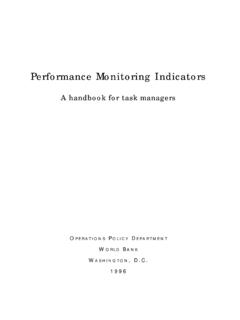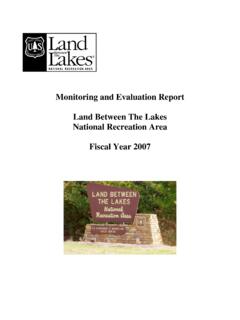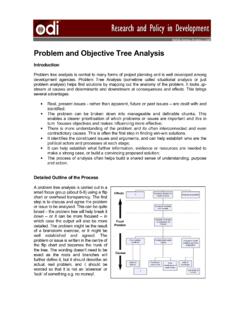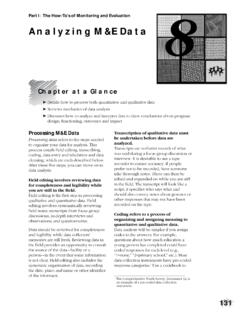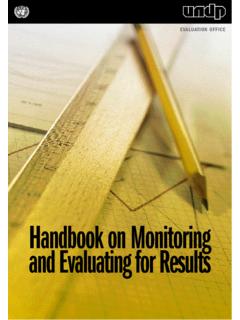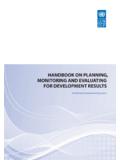Transcription of Handbook for Monitoring and Evaluation
1 Handbookfor Monitoringand Evaluation1st EditionOctober 20022002 International Federation of Red Cross and Red Crescent SocietiesPO Box 372CH-1211 Geneva 19 SwitzerlandTelephone: +41 22 730 4222 Telefax: +41 22 733 0395 Telex: 412 133 FRC CHE-mail: site: International Federation of Red Cross and Red Crescent SocietiesAny part of this brochure may be cited, copied, translated into other languages or adapted to meet local needs without prior permission from theInternational Federation of Red Cross and Red Crescent Societies, provided that the source is clearly stated. Foreword I am hoping that all stakeholders throughout the Federation will receive this first edition of the Monitoring and Evaluation Handbook warmly. The ever-changing development landscape accompanied by the increased challenges of accountability, performance, quality standards and learning make this a timely publication for the Monitoring and Evaluation Division.
2 It is a collection of tools each of which is designed to support the Monitoring and Evaluation function. As a management responsibility, Monitoring activity provides the basic building blocks of decision-making, for strategic planning and resource mobilisation. It is a key measurement activity in our efforts at achieving organisational effectiveness. If we cannot cannot manage. Although it is primarily aimed at stakeholders in the field, it is nonetheless an interesting useful resource for all practitioners that share the common goal of effectively serving the most vulnerable in our world. It is an evolving initiative and this first edition deserves critical appraisal. The variety of tools available for use in this Handbook are offered and presented in an interesting, simple and readable format. Its harmonised terminology facilitates use alongside the Project Planning Process (PPP) and Better Programming Initiative (BPI).
3 The 2nd edition of the Handbook will be available in Spanish, French and Arabic. As a vehicle for organisational shared learning, we look forward to receiving your helpful input to make the 2nd edition an even more relevant and effective contribution to the achievement of the International Federation s goals and Osman Monitoring and Evaluation Division October 2002 Contents Introduction iModule 1 Section Page 1 Overview 1-1 Objective of the guidelines 1-1 What is in the guidelines? 1-1 Principles and definitions you should be aware of 1-3 Results Based Management 1-3 Linking Monitoring and Evaluation to the logical framework 1-4 What is Monitoring ?
4 1-5 What is Evaluation ? 1-6 Monitoring and Evaluation throughout the lifespan of an operation 1-7 What is the operational framework for Evaluation ? 1-8 The purpose of the new framework on Monitoring and Evaluation 1-8 Principles of results oriented M&E in International Federation 1-8 International Federation s approach to Monitoring and Evaluation 1-8 The approach to results-oriented Monitoring 1-8 The approach to results-oriented evaluations 1-9 Lessons to learn from Module 1 1-10 Module 2 2 Monitoring and Evaluation 2-1 How to design a Monitoring and
5 Evaluation System 2-1 Checking operational design 2-2 How clearly are the objectives stated? 2-2 Have external factors been taken into account? 2-2 Will indicators effectively measure progress? 2-3 Beneficiary contact Monitoring indicators (BCM) 2-4 Assessing capacity for Monitoring and Evaluation 2-5 How to determine M&E capacity 2-5 Assessing training needs 2-5 Conducing a training needs analysis 2-5
6 Planning for data collection and analysis 2-7 Why do we need baseline data? 2-7 What Monitoring data are required and where will they come from? 2-8 What Monitoring data are required 2-8 Input Monitoring 2-8 Field visits 2-8 Monitoring participation 2-9 Monitoring and evaluating commitments to women 2-9 Who undertakes data collection and analysis
7 At the field level 2-9 Computerised systems for Monitoring 2-11 Preparing the Monitoring and Evaluation plan and budget 2-12 The Monitoring and Evaluation plan 2-12 The Monitoring and Evaluation budget 2-12 Planning for reporting and feedback 2-14 Guidance for Monitoring and Evaluation report writing 2-14 How would project/programme managers use reports? 2-14 Monitoring the partners reporting system 2-15 Feedback 2-15 Lessons to learn from Module 2 2-16 Module 3 Section Page3 Monitoring and Reporting National Society Programmes 3-1 How to design an M&E programme for National Societies 3-1 Check the National
8 Society programme and activity design 3-2 At national society level 3-2 At activity level 3-2 Assessing capacity for M&E for co-operation agreement strategy 3-4 How to determine M&E capacity for co-operation strategy and activities 3-4 Assessing training needs for co-operation agreement strategy and activities 3-4 Planning for data collection and analysis for Co-operation agreement strategy 3-5 What baseline data are required? 3-5 What Monitoring data is required, and where will it come from 3-6 Field visits 3-6 Beneficiary contact Monitoring , beneficiary access, use and satisfaction 3-6 Who undertakes data collection and analysis at the field level?
9 3-6 Preparing the M&E plan and budget 3-7 The M&E plan 3-7 The M&E budget 3-9 Planning for Reporting and Feedback 3-10 Written reports 3-10 How would project/programme managers use reports Feedback for co-operation agreement strategy and activities 3-10 Lessons to learn from Module 3 Module 4 4 Monitoring and Reporting 4-1 What is particular about Monitoring and Evaluating?
10 4-1 How to design a Monitoring and Evaluation system (reminder) 4-2 Checking operation design 4-3 M&E considerations in project cycle stages 4-3 Reviewing or preparing a logframe 4-4 Assessing capacity for Monitoring and Evaluation 4-5 Defining roles and responsibilities for Monitoring 4-5 Assessing capacity for Monitoring 4-5 Planning for data collection and analysis 4-7 Baseline data
